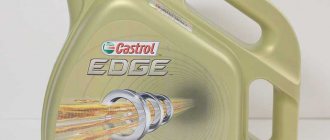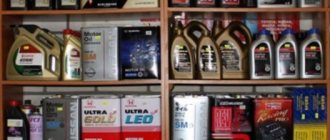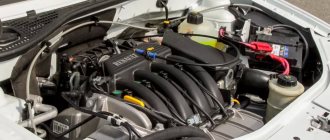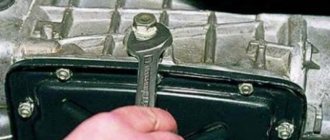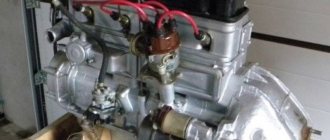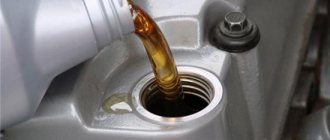VAZ-2107 is a classic car, which is an updated version of the VAZ-2107 from the 1970s. Since those times, the design of the machine has essentially not changed. But on the other hand, this can be considered an advantage, since the VAZ-2107 is well suited for independent maintenance - this can be confirmed by the fact that such cars are almost never available at Lada branded dealership centers. The owners serve them themselves, without much effort. And since there are a lot of such people, that means there are a huge number of questions about service. For example, the most popular of them is how much oil to fill in the VAZ-2107 engine. In addition, novice and experienced owners of the car in question are interested in information on the choice and type of oil, as well as the frequency of replacement.
Replacement Regulations
The manufacturer advises changing the engine oil in the VAZ-2107 engine every 10 thousand kilometers. But this is a conditional indicator that can be reduced or increased depending on the condition of the oil. For example, if it darkens and stinks ahead of schedule, then an oil change will be required at the 6th or 7th thousand. Since the VAZ-2107 is an unpredictable car, the rule is that it is better to change the oil in advance. If you are late with an oil change, you may face irreversible consequences. It may come down to a major overhaul of the engine. But on the other hand, the oil can last for 15 thousand kilometers if the car is operated in favorable climatic zones - for example, on good roads, in warm weather, and without frost.
The most popular articles on the site:
- How often should you change engine oil?
- Oil 5w30 and 5w40 what is the difference
- What oil to pour into the engine in winter and summer
- How long does it take to change the automatic transmission oil?
Step-by-step instructions for changing the oil
Before starting work, prepare all the necessary tools and consumables:
- Socket wrench set
- Oil filter puller
- Container for collecting waste with a volume of at least 5 liters
- 4 liters of fresh motor oil
- Funnel
Place the car on an overpass or inspection hole, start it and let it idle for 10 minutes. During this time, the engine oil will become as liquid as possible.
Open the hood and unscrew the filler cap by hand. Place a container for collecting waste under the drain hole in the crankcase, unscrew the plug with a socket 12.
Wait until the oil is completely drained. This may take 15-20 minutes.
If the fluid is already old and viscous, some of it will remain on the engine walls, in small channels and holes. In this case, it is better to rinse it. To increase the effectiveness of this procedure, raise the rear right wheel of the car by 15-20 cm with a jack.
Before washing, remove the old oil filter and temporarily install the cheapest new one in its place.
Close the drain hole and pour approximately 4.5 liters of diesel fuel (diesel fuel) into the oil neck. Place the plug on the neck and crank the starter for 15 seconds. Do not start the engine completely.
Drain the dirty diesel fuel through the hole in the crankcase, install a new oil filter and fill in about 3.75-4 liters of fresh oil through the oil neck. Replace the filler plug and wait 5-10 minutes for the lubricant to settle. After this, measure its level with a dipstick. The oil trace should be between the MIN and MAX marks.
Start the engine and make sure that the oil pressure light, which initially lights up, goes out after 5-10 seconds. Turn off the car and after 20 minutes recheck the oil level, as well as the oil filter and plug for leaks.
Which oil to choose
Before you know the oil volume, you should pay attention to the most important oil parameters. We are talking about viscosity characteristics, as well as the API quality grade, which is designated as the letters SH, SH, SJ and SL. As for viscosity, here we need to take into account the set of numbers before and after the letter W. For example, the first number (before the W) indicates the cold start temperature, and the second indicates the viscosity. If the car is new, the viscosity should be at the level of -30, and with 100 thousand mileage - 50. If the mileage is even higher, then a viscosity with a figure of 60 or more is suitable.
As for choosing a brand, it all depends on brand preferences. But it is advisable to choose among well-known companies. Among the most trusted companies, we note Shell, Lukoil, Mobile, Castrol, Texaco and Motul.
How much oil to pour into the VAZ 2107 engine
First generation 2107, 1982-2013
Unlike the “five,” model 2107 was equipped with a more modern 77-horsepower 1.5-liter engine, as well as an improved exterior and interior. Thus, the car received a new radiator grille in the style of old Mercedes, as well as original taillights, new front seats and a front panel with tachometers. Some interior trim elements have changed. In 2008, a version appeared with a 73-horsepower 1.5-liter engine, which had distributed injection. Total production of the 2107 was 3.1 million units.
Also read: Motor oil for Toyota Hilux Surf engine
Gasoline engines 1982-2012
- 1.3 64 l. With. (2105), oil volume - 3.75 liters, tolerance and viscosity: API-SG, SJ, SL, SM; SAE 5W-40, 10W-40, 10W-30, 5W-30, 0W-40, 0W-30, 20W-40
- 1.5 68 l. With. (2103), oil volume - 3.75 liters, tolerance and viscosity: API-SG, SJ, SL, SM; SAE 5W-40, 10W-40, 10W-30, 5W-30, 0W-40, 0W-30, 20W-40
- 1.5 72 l. With. (2103), oil volume - 3.75 liters, tolerance and viscosity: API-SG, SJ, SL, SM; SAE 5W-40, 10W-40, 10W-30, 5W-30, 0W-40, 0W-30, 20W-40
- 1.6 73 l. With. (2106-20), oil volume - 3.75 liters, tolerance and viscosity: API-SG, SJ, SL, SM; SAE 5W-40, 10W-40, 10W-30, 5W-30, 0W-40, 0W-30, 20W-40
- 1.6 74 l. With. (21067), oil volume - 3.75 liters, tolerance and viscosity: API-SG, SJ, SL, SM; SAE 5W-40, 10W-40, 10W-30, 5W-30, 0W-40, 0W-30, 20W-40
- 1.6 75 l. With. (2106), oil volume - 3.75 liters, tolerance and viscosity: API-SG, SJ, SL, SM; SAE 5W-40, 10W-40, 10W-30, 5W-30, 0W-40, 0W-30, 20W-40
- 1.7 79 l. With. (21213), oil volume - 3.75 liters, tolerance and viscosity: API-SG, SJ, SL, SM; SAE 5W-40, 10W-40, 10W-30, 5W-30, 0W-40, 0W-30, 20W-40
Types of oil
- Synthetic is the thinnest oil. Due to its fluidity, such a liquid is very resistant to low temperatures and never freezes in cold weather. Recommended for new cars, including VAZ-2107 with low mileage.
- Mineral oil is the cheapest and thickest oil. Perhaps these are all its advantages. Not suitable for low temperatures, but it will be the best option for cars with high mileage.
- Semi-synthetic is a cheaper oil than pure synthetics. But at the same time, its advantages pale in comparison to real synthetic oil. And yet, semi-synthetic is definitely better than mineral oil. Considering the fact that the car is cheap, this oil is suitable for it.
Oil filter device
The non-separable filter used on “classic” VAZ models is a stamped cylindrical element, on which edges are provided for a chain or ring wrench. Inside there is a filter cartridge made of paper, which is held in place by a lid. Oil is supplied through a valve that prevents the discharge of contaminated lubricant into the crankcase. The filter is screwed onto a threaded fitting and has a rubber O-ring. The cleaning element is changed when fresh lubricant is poured into the engine sump.
An oil filter is a special device designed to clean oil from solid particles.
Replacement of gas tank and major repairs
Regardless of what type of fuel injection is used on your vehicle, the process for removing the tank will be the same. First drain all fuel from it. Next, carry out the following work:
- Remove the plastic casing from the container. To do this, you will need to unscrew several screws using a Phillips screwdriver.
- Disconnect the wires from the contacts leading to the fuel sensor.
- Use pliers to pry off the fuel hose.
- Unscrew the bolt of the tension plate that secures the gas tank.
- Remove the cap from the neck and carefully remove the tank.
Assess its condition. If there are several leaks or they are too large, then it will be easier to replace the entire fuel container. To do this, simply take a new tank and reassemble it in the reverse order.
If you do not have the opportunity to buy a new container, then stock up on:
- fiberglass;
- epoxy resin;
- acetone;
- sanding paper.
For injection system
Forced fuel supply in the "seven" for the Russian market began to be used in 2006. In these car models, the fan operation and other functions are performed by the ECU. On the VAZ 2107 injector, the signal about the antifreeze temperature comes from the coolant temperature sensor, which is located on the right side of the engine cylinder block.
The data is processed by the ECU, which outputs a signal to the control relay to turn on the cooling - circuit diagram. The fan switching sensor is not needed on VAZ 2107 injection systems; it is replaced by a thermistor sensor, and control functions are assigned to the controller.
In any “seven”, to protect the fan from short circuit, there is a fuse F7 located in the mounting block.
Operation of the coolant temperature sensor for the injection system
Usually, turning on the fan on a VAZ 2107 is accompanied by a noise that the driver hears while sitting behind the wheel. A prolonged absence of sound from the device when driving around the city in the summer may indicate a malfunction in the cooling system, which can lead to antifreeze boiling and damage to engine components. The driver must react quickly to such defects so as not to spoil the “heart” of his car.
One of the possible malfunctions in the engine cooling cycle may be a breakdown of the coolant temperature sensor. In addition to the cooling system, it is responsible for the correct supply of the air-fuel mixture to the engine and its inclusion in idle mode.
The sensor that affects the operation of the VAZ 2107 injector fan consists of a semiconductor thermistor with two terminals, soldered into a housing with a thread that is screwed into the wall of the cylinder block. A constant voltage of 5 V is supplied to the device. As the temperature of the antifreeze increases, the resistance of the thermistor decreases and vice versa. At the input to the computer, passing through a resistor, the voltage drops as the coolant temperature increases to a certain level, after which the controller gives a signal to turn on the cooling.
How to check and install a new one
Checking the sensor responsible for turning on the fan does not require much effort. The following signs may serve as grounds for verification:
- The “Check Engine” light on the instrument panel is on.
- The fan operates continuously or is turned off.
- Low idle torque.
- Coolant overheating.
The cause of the malfunction may be outdated wiring. To find out for sure, you need to check it, and then move on to the sensor.
For this:
- The negative cable of the battery is disconnected.
- On a cold engine, the antifreeze drains to a level below the temperature sensor socket.
- The protective layer is shifted and the wiring from the temperature sensor is disconnected.
- Use a key to unscrew the sensor from its socket.
Next, check using a multimeter and boiled water. The multimeter is connected to the outputs of the temperature sensor and set to resistance measurement mode. The threaded side is placed in boiling water. If the resistance tends to zero, then the sensor is working. Otherwise, if increased resistance readings appear, the sensor requires replacement.
To replace it, it is better to purchase the same model that was installed when purchasing the car. Installation of a new sensor occurs similarly in the opposite direction.
Cleaning and preventing plaque in the system
The injector device is very sensitive to large inclusions in gasoline. If you are using a cheap brand of fuel, be prepared to change your injectors soon. So the first thing you should do for your VAZ fuel pump is change the brand of fuel. The power supply system of the VAZ 2107 should become cleaner; the possibility of plaque formation in the system is still not excluded. Since the flammable liquid in the channels occasionally stagnates and sometimes even freezes, an early breakdown can be prevented only in one way - regular cleaning.
Approximately every 35-40 thousand km it is necessary to carry out preventive cleaning work on the fuel system. You need to wash the channels with your own hands. The performance of the engine will depend on the quality of cleaning. If this procedure is carried out irregularly, then soon you can say goodbye to one injector and look for a new one, and then you will have to change the remaining elements of the VAZ fuel pump.
In 4-cylinder types of injection engines, different intensities of injector clogging are observed. The temperature in the area of cylinders 2 and 3 is always elevated, so sediment accumulation occurs there faster.
A special admixture of polyetheramine is considered a prophylactic agent in such cases. It prevents the accumulation of burning for a long time.
